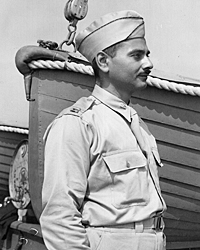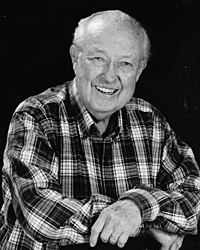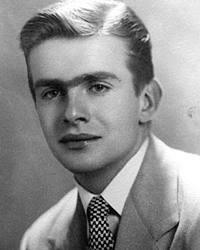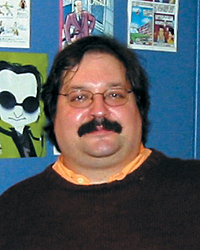|
|
|
OBITUARIES
[Corrections: In the May issue, the obituary
for Lloyd M. Moglen ’60 contained
several errors: his date of death was August 2,
2002; he was born in 1938; and his radio talk show
was on KQED. CCT apologizes for these mistakes.]
 |
|
1929
|
 |
| 
|
| |
| John
W. Marchetti '29 |
 |
John W. Marchetti, retired engineer,
Cherry Hill, N.J., on March 28, 2003. Marchetti
was enrolled in a six-year program that provided
liberal arts as well as graduate electrical engineering
education. He was at the College from 1925–27,
where he earned an A.B., and then was in the electrical
engineering department from 1928–31, receiving
a B.S. in 1930 and an E.E. in 1931. He began his
career at Camp Evans, N.J., as a pioneer in the
development of early radar systems. Working in his
lab, Marchetti created prototype radars, including
the one used to detect the attack on Pearl Harbor.
He also developed a mortar locator used to intercept
enemy fire. Marchetti served in the Navy, the Army
Signal Corps and the Air Force, from which he retired
as a lieutenant colonel, serving in England and
France during WWII. Among his military honors was
the Order of the British Empire. Following the war,
Marchetti moved to Massachusetts to assume the post
of founding technical director of the Air Force
Cambridge Research Center. There, he was responsible
for the center’s three divisions: electronics,
geophysics and atomic warfare. Later, Marchetti
developed the prototype for the electronically steerable
array radar system. In 1962, he founded a research
engineering company and worked on defense systems
and high-speed rail technology. The latter work
brought him back to New Jersey, where he retired
about 10 years ago. Marchetti held numerous patents.
In 1999, he received the Normandy Medal from the
Federation of French War Veterans. Marchetti is
survived by his daughter, Nina M. Archabal, and
her husband, John; son, John J. Jr. and his wife,
Joyce; sister, Josephine; two grandsons; and one
great-grandson. His wife, Santina (neé Giuffre),
predeceased him. Donations may be made in Marchetti’s
memory to Samaritan Hospice, 5 Eves Dr., Ste 300,
Marlton, NJ 08053.
Alan F. Perl, retired lawyer,
Sarasota, Fla., on December 7, 2002. Perl was born
on May 3, 1909, in New York City, and grew up in
Brooklyn. Following graduation from the Law School
in 1931, he practiced law during the Great Depression,
working in New York City and then in White Plains.
In 1935, with the passage of the Wagner Labor Act,
he joined the National Labor Relations Bureau as
a regional attorney. During his time with the NLRB,
he successfully tried a long series of cases against
major national corporations, which secured the rights
of working men and women to organize and bargain
collectively in order to receive a living wage and
humane working conditions. Among his opponents were
Ford, Pittsburgh Plate Glass, General Electric,
Shell Oil and The New York Times. This
body of work established many of the legal rights
of workers that most now take for granted. Perl
rose in the ranks of the NLRB to become regional
director of its New York office. In 1945, Rexford
Tugwell, then governor of Puerto Rico and one of
Perl’s former law professors at Columbia,
asked him to assist the Puerto Rican government
in writing the labor laws for the island and assist
in getting them passed in the legislature. These
laws formed a major basis for “Operation Bootstrap,”
which succeeded in greatly strengthening Puerto
Rico’s economy. For the next 30 years, Perl
served as an adviser on legal matters to Puerto
Rico’s labor secretary and was responsible
for negotiating the contracts for Puerto Rican agricultural
workers who picked fruits and vegetables throughout
the eastern coastal states. These contracts assured
adequate work, decent wages, workman’s compensation
coverage and acceptable living conditions for the
workers and remain a model for many other migrant
worker programs. In 1947, with the passage of the
Taft-Hartley Bill, Perl left the NLRB in protest,
feeling that many of the rights that he had helped
to secure would be undermined. Joining with Jerome
Sturm, he was a founding partner in the law firm
of Sturm and Perl, specializing in labor law. Perl
retired in 1976 and ultimately moved to Sarasota
to enjoy fishing, golf and a warmer climate. He
was a loyal son of Columbia and spoke warmly of
his days as an undergraduate. A member of AEPi,
many of his fraternity members became lifelong friends.
His wife of 49 years, Florence, died in 1984. He
is survived by his son, Daniel ’63; daughter,
Emily Perl Kingsley; three grandchildren; and one
great-grandchild.
 |
|
1934
|
 |
Edward J. Finn, Asheville, N.C.,
on February 21, 2003. Finn received a second bachelor’s
degree, from the School of Architecture, in 1937.
Formerly of Horse Shoe, N.C., and Oradell, N.J.,
he was predeceased by his wife, Alice Laird Van
Varick. He is survived by his daughter, Kathleen
Finn Evascu; son, Edward Van Varick Finn ’69,
’72L; two granddaughters; brother, William
Stephen Finn; and Georgette Kohlrieser. Finn requested
that donations be made to the Class of 1934 in his
honor.
 |
|
1939
|
 |
Myron C. Patterson, physician,
New York City, on February 8, 2003. A 1943 graduate
of P&S, Patterson was an attending physician
at St. Luke’s-Roosevelt Hospital Center cardiology
staff for more than 50 years as well as associate
clinical professor of medicine at P&S. He was
committed to the education of physicians in the
diagnosis and treatment of heart disease. Patterson
is survived by his wife of 60 years, Michaeleen
(O’Rourke); daughter, Anne Baier, and son-in-law,
J. Cletus; daughter; Linda Kocsis, and son-in-law,
William; and eight grandchildren. Contributions
may be made to the Myron C. Patterson Heart Fund,
Roosevelt Hospital, 1000 Tenth Ave., New York, NY
10019.
 |
|
1941
|
 |
| 
|
| |
| Samuel
W. “Chips” Hughes |
 |
Samuel W. “Chips” Hughes,
businessman, Saddle River, N.J., on June 9, 2003.
Hughes was born in the Bronx to Irish immigrants
and attended DeWitt Clinton H.S. While at the College,
Hughes was president of the Blue Key Society in
his junior and senior years, v.p. of Beta Theta
Pi, a member of the King’s Crown Advisory
Board and a member of the Sachems Honor Society.
He narrowly lost the “Student Who Had Done
the Most for the College” election to Joseph
Coffee ’41. Hughes was elected into Who’s
Who in American Colleges and Universities and
played varsity baseball. Volunteering for military
service, Hughes was commissioned as a Navy pilot
and rose in rank to become a lieutenant senior grade,
flying antisubmarine warfare dirigibles. He escorted
the convoy that carried President Roosevelt to the
historic Yalta meeting. After the war, Hughes joined
with home furnishing legends Charles Eames and Herman
Miller and also held senior executive positions
with Hess Goldsmith, Burlington Industries and Bedford
Weaving. He was instrumental in introducing plastic
sheeting for upholstery, in making modern furniture
available to the mass market and in developing fiberglass
for the curtain and drapery market. Hughes served
on many collegiate, community and church boards
and headed several. He earned the nickname “Chips”
at the poker table. Hughes is survived by his wife
of 60 years, Dorothy Runals Hughes ’42 Business;
sons, Terry and Brian ’68; daughter, Kathy;
sister, Elizabeth Waller; and five grandchildren.
Donations in Hughes’ memory may be made to
the Blair Fund, Office of Development, PO Box 600,
Blairstown, NJ 07825.
Vernon W. Hughes, retired physicist,
New Haven, Conn., on March 25, 2003. Hughes was
a Yale physicist whose investigation of muons —
rare and relatively heavy cousins of electrons —
poked holes in standard subatomic theory and provided
evidence for the existence of previously undetected
matter. Hughes was born in Kankakee, Ill. While
at Columbia, he was a student of Nobel Prize-winning
physicist Isidor Isaac Rabi and graduated with honors
in mathematics and physics. He received a master’s
and Ph.D. from GSAS, the latter in physics in 1950.
During WWII, Hughes worked at MIT’s radiation
laboratory, helping develop radar. In 1954, he joined
the Yale faculty and played a major role five years
later in originating the use of polarized beams
in high-energy accelerators. Hughes continued to
work on the mechanics of the proton as leader of
a research team at CERN, the European particle physics
laboratory near Geneva. His investigations there
contributed to the understanding that protons have
gluons as well as quarks, and that both of them
contribute to protons’ spin. Hughes began
his study of muons in 1960. He developed increasingly
precise techniques for measuring their properties,
culminating in an experiment at Brookhaven National
Laboratory to assess their response to powerful
magnetic fields. Hughes’s experiment showed
muons moving in unexpected ways, suggesting that
other, unknown particles exist in the subatomic
world. Announced in February 2001, the results of
the experiment were seen by some physicists as evidence
supporting a theory called supersymmetry, which
assumes the existence of new particles, known as
supersymmetric partners, for each of the known particles.
Hughes retired from Yale in 1991 as one of its prestigious
Sterling professors. His first wife, Inge, died
in 1979. He is survived by their sons, Gareth and
Emlyn; his second wife, Miriam; and four grandchildren.
 |
|
1943
|
 |
Joseph T. Carty, Tequesta, Fla.,
on April 9, 2003. Carty was elected president of
his class and resigned in 1943 to join the Army,
prior to his graduation ceremony. He received his
diploma by mail. Carty received the Alumni Medal
in 1982. Among his survivors are his wife, Merry;
daughter, Barbara Bodine; and granddaughter, Blair
Bodine ’06, who, according to her mother,
“entered her Columbia experience with a deep
reverence and respect for the community, kinship
and friendship that endures with love and loyalty.”
 |
|
1947
|
 |
Bernard Steinberger, retired physician,
Highland Beach, Fla., on April 8, 2003. Steinberger
was born on October 22, 1924, in Brooklyn. A WWII
veteran, he was a 2nd lieutenant in the Air Force.
Steinberger graduated from P&S and SUNY Downstate
Medical Center in 1951. From 1951–52, he interned
at Jewish Hospital in Brooklyn. From 1952–55,
he was a resident OB/GYN at Maimonides Medical Center,
also in Brooklyn. Steinberger retired in 1990 from
Maimonides Medical Center and St. John’s Hospital
(Far Rockaway, N.Y.). He is survived by his wife,
Sandy Berkowitz-Steinberger; sons, Robert, Carl,
Joshua and Paul; two grandchildren; stepchildren,
Jill and Jay Glasser, David Forrest and Glen Berkowitz;
and three stepgrandchildren. His brother, Marvin,
predeceased him. Memorial donations may be made
to The Dr. Bernard Steinberger National Fragile-X-Foundation,
4408 Intracoastal Dr., Highland Beach, FL 33487.
 |
|
1952
|
 |
| 
|
| |
| Frederic
G. Sibley '52 |
 |
Frederic G. Sibley, retired advertising
executive, Greenwich, Conn., on March 12, 2003.
Sibley was born on November 6, 1928, in Dorchester,
Mass. He was a descendent of Edward Fuller, who
came over on the Mayflower, and was the 10th generation
grandson of Roger Williams, founder of the State
of Rhode Island and Providence Plantation. Sibley
was a direct descendent of John Sibley, who came
from England in 1629 in Winthrop’s Fleet.
He attended Mary E. Wells H.S. in Southbridge, Mass.,
and Suffield Academy, graduating in 1948, before
attending the College, where he was a member of
Sigma Chi fraternity. Sibley joined the advertising
staff of The Wall Street Journal in New
York in 1953 and was promoted and transferred to
Atlanta, Cleveland and Chicago, returning to the
New York office in 1966. He lived in Greenwich since
that time. Sibley served as the advertising director
of Barron’s and the National
Observer and, in 1974, was named special projects
manager for The Wall Street Journal’s
advertising sales department. He retired in 1992,
only to return as the archives consultant for Dow
Jones & Co., until his heart condition sidelined
him in 1996. Sibley was a member of the Greenwich
RTM for more than 25 years, as well as the selectman’s
parking committee, the appointments committee and
Using Senior Energy. He was a justice of the peace
for the Town of Greenwich and performed many marriages.
He also was a member of the board of directors of
the YMCA Camp Woodstock in upstate Connecticut,
where he was a camper and counselor for many years.
Sibley is survived by his wife of 50 years, the
former Doris Paul; son, Frederic G. Jr.; daughters,
Persis Merritt, Sarah Jura, Perrin Galli and Justine
Tully; and nine grandchildren. Memorial donations
may be made to Camp Woodstock, 42 Camp Rd.,
Woodstock Valley, CT 06282.
Charles A. Steers, retired financial
officer, Naples, Fla., on March 28, 2003. Born in
1930 in Portland, Ore., Steers and his wife of 52
years, Betty, graduated from Ponce de Leon H.S.
in Coral Gables, Fla. After the College, Steers
joined General Electric, where he worked in corporate
finance for 36 years until his retirement in 1988.
He and Betty moved from Essex, Conn., to Naples
in 1994. Always active in a variety of volunteer
positions, Steers was a past president of the Friends
of the Library of Collier County. Survivors include
his wife; daughters, Chris Barette, Carol Lane and
Cather Jenks; and four grandchildren.
 |
|
1953
|
 |
Richard A. Givens, attorney, Flushing,
N.Y., on February 7, 2003. Born in New York City
on June 16, 1932, Givens earned an M.S. in economics
from the University of Wisconsin in 1954 and an
L.L.B. from the Law School in 1959, where he tied
with Ruth Bader Ginsberg for first place in their
class. He was admitted to the New York bar the same
year. Givens served in the Army from 1954–56.
Among his professional appointments were U.S. District
Court (southern and eastern districts), N.Y., 1960;
U.S. Court of Appeals (2nd circuit), 1962; U.S.
Supreme Court, 1966; U.S. Court Claims, 1980; and
the U.S. Court of Appeals (4th circuit), 1981. Givens
was an associate with Hughes, Hubbard & Reed
in New York City from 1959–61; an assistant
U.S. attorney in the southern district of New York,
1961–71; and regional director of the FTC,
New York City, from 1971–77. He also served
as counsel for Botein, Hays & Skylar, New York
City, from 1977–89; was law clerk to Hon.
Vincent L. Broderick, U.S. District Court (southern
district) N.Y., White Plains, 1992–95; and
law secretary to Hon. Jay Gold, acting Supreme Ct.
Justice, 1995–96. Givens was chairman of the
program on drafting documents in plain language,
1981, and authored Manual of Federal Practice
(5th ed., 1998); Advocacy: The Art of Pleading
a Cause (3rd edition, 1992); Legal Strategies
for Industrial Innovation, which won the “Best
Law Book of 1982” award from the Association
of American Publications (1982); and Antitrust:
An Economic Approach (1983). He also contributed
to professional journals and was a member of the
ABA, New York State Bar Association and Association
of the Bar of the City of New York. Givens is survived
by his wife, Janet Eaton, whom he married in 1957;
and daughters, Susan Ruth and Jane Lucile.
 |
|
1943
|
 |
George O. Rudkin Jr., chemist, Chadds Ford,
Pa., on February 10, 2003. Rudkin was born in New
York City and received a Ph.D. in chemistry from
the University in 1946. He became associate director
of the product development department for ICI United
States in Wilmington, Del. His wife of 58 years,
Helene ’45 Barnard, said in a note to CCT:
“[George] was always most appreciative of
his Columbia University education and training under
Professor Nelson of the chemistry department.”
In addition to his wife, Rudkin is survived by his
daughters, Mary Ellen, Christine Louise, Noreen
Anne and Amy Josephine; son, George Henry; 10 grandchildren;
great-granddaughter; and brother, Robert. Donations
may be made to a charity of the donor’s choice.
 |
|
1972
|
 |
Gerrit Henry, art critic and poet,
New York City, on May 1, 2003. Henry attended Long
Island public schools prior to attending the College.
As an undergraduate, he worked at the information
desk of the Museum of Modern Art, and he was recruited
by poet John Ashbery, then an editor at Art
News magazine, to write art reviews. Henry
graduated with an English degree; he studied poetry
with the late Kenneth Koch. Henry was best known
for his widely published writings on art, in which
he tended to favor contemporary combinations of
traditional representation and modernist abstraction.
Henry became contributing editor for Art News and
wrote reviews for Art in America magazine. His writings
also appeared in The Village Voice, People,
Art International, Spectator, The New Republic
and The New York Times. He also wrote many
essays in exhibition catalogs. An accomplished poet,
Henry’s witty, confessional poetry, often
written in couplets, was influenced by the songs
of Cole Porter and Steven Sondheim. His books of
poetry include The Mirrored Clubs of Hell: Poems
by Gerrit Henry (Little, Brown & Co., 1991)
and Poems and Ballads (Dolphin, 1998).
He also wrote a book on realist painter Janet Fish,
Janet Fish: A Monograph (Burton & Skira,
1987). Henry had a brief career as a cabaret singer
and songwriter in the 1970s. He is survived by his
mother, Mary Jane Henry; and sister, Janice Henry,
who said of him, “Gerrit valued his years
at Columbia and was proud of the fact that he was
an alumnus of the College.”
Paul F. Wotman, attorney, San
Francisco, on December 25, 2000. A native of Great
Neck, N.Y., Wotman was a pioneering gay-rights attorney.
He first broke ground in anti-discrimination law
as a student at UC Berkeley’s Boalt Hall School
of Law, where he led the newly-founded Gay Law Students
Association in a suit against Pacific Telephone,
which led to a landmark state Supreme Court ruling
in 1979 protecting openly gay and lesbian employees
from job discrimination on the grounds that their
sexual orientation was a form of political expression.
Fourteen years later, after then-Gov. Pete Wilson
signed California’s first law banning employment
discrimination because of sexual orientation, Wotman
rushed to the courthouse with several damage suits
on the day the law took effect. A 1991 case led
to a $5.3 million damage award, then the largest-ever
for a gay-rights employment case. Wotman also filed
some of the first suits alleging same-sex sexual
harassment and numerous suits alleging job discrimination
based on HIV infection. In the mid-1980s, Wotman
served as chairman of the Alliance, a San Francisco
gay political action committee, and was on the board
of Bay Area Lawyers for Individual Freedom. He started
his private law practice in 1982 after working as
a lawyer for the state Occupational Safety and Health
Administration, and, according to his office, represented
more than 2,200 clients in discrimination suits
in the past 15 years. Wotman is survived by his
partner, Danny Scheie; parents, Robert and Anita
Wotman; and brothers, David and Daniel. Contributions
in Wotman’s name may be made to the Human
Rights Campaign, 919 18th St. N.W., Ste 800, Washington,
DC 20006, or the Lambda Legal Defense and Education
Fund, 6030 Wilshire Blvd., Ste 200, Los Angeles,
CA 90036.
 |
|
1985
|
 |
| 
|
| |
| Andrew
Kosoresow '85 |
 |
Andrew Kosoresow, professor, New
York City, on June 1, 2003. Kosoresow was an assistant
professor of computer science at the Engineering
School. He joined Columbia’s faculty in 1997
after teaching at the University of New Mexico and
Stanford, from which he received his Ph.D. His major
research areas were combinatorial algorithms, artificial
intelligence, distributed and parallel computing,
and graph theory. In 1998, Kosoresow helped revive
the Columbia chapter of the Association for Computing
Machinery, a group that organizes events and provides
pre-professional support for students interested
in computer science. In 2001, he received the Kim
Award for Faculty Involvement from the Engineering
School. Kosoresow was a well-liked instructor and
a skilled administrator, serving as the assistant
department chairman for undergraduate education
for computer science. But he was perhaps best known
as a mentor, adviser and friend to countless undergraduates
and graduates in a department of 500 students. “He
would always give time to a student,” said
Professor of Computer Science Alfred Aho, the department
chairman. “Many faculty are just too busy
to drop everything to pay attention to a student,
but he would always give time.” Kosoresow’s
dedication to undergraduates extended to his substantial
work on behalf of the department’s TAs, to
whom he was responsible for assigning to classes.
Kosoresow also taught a class, Computer Science
Education, which instructed TAs in how to effectively
teach computer science. Former students recalled
that he had a habit of wearing shorts even in the
winter, that he sometimes threw candy or brownies
(for brownie points) at students when they got a
correct answer, and that, on exams, he often gave
extra credit questions such as, “What cartoon
character do I look like?” or trivia from
Ghostbusters. The computer science department
is planning a second memorial service — one
was held in the spring — for Kosoresow this
fall. He is survived by his mother, Claudia Kosoresow.
L.P.
Other Deaths Reported
Columbia College Today has learned of
the deaths of the following alumni (full obituaries
will be published if information becomes available):
1922 Irvin J. Bussing,
San Francisco, on May 28, 2003. Bussing earned
a Ph.D. in economics from GSAS in 1935.
1930 Robert Blumofe, motion
picture producer, West Hollywood, Calif.,
on July 24, 2003. Blumofe earned a degree
from the Law School in 1932.
1932 Adam Frank Jr., poet,
philosopher and behavioral scientist, Chevy
Chase, Md., on April 17, 2003.
1933 Edward L. Nehez, Northvale,
N.J., on April 25, 2003.
Orpheus A. Rogati, Whiting, N.J., on April
15, 2003.
1936 Edmund A. Furey, Brewster,
N.Y., on August 6, 2002. Furey was a member
of the famed 1934 Rose Bowl football team.
He was predeceased by his wife, Peggy, and
is survived by his daughters, sons-in-law,
grandchildren and great-grandchildren.
1938 Edward G. Menaker,
Waynesboro, Va., on February 24, 2003. A longtime
John Jay associate, Menaker earned a master’s
in French and romance philology in 1939 from
GSAS. His survivors include his wife, Elizabeth;
and son, Richard ’69.
1940 Robert A. McKean,
Camarillo, Calif., on April 1, 2003.
1942 Nicholas J. DeVito,
Huntington, N.Y., on March 3, 2003.
1949 Robert J. Williams,
Midland, Mich., on April 16, 2003. Williams
earned his master’s in electrical engineering
from the Engineering School in 1949 and a
doctorate in psychology from GSAS in 1953.
1960 John J. Coveney, Belle
Harbor, N.Y., on December 27, 2002.
1970 Terence J. Kinsman,
attorney, Los Angeles, on February 5, 2003.
Kinsman earned a degree from the Law School
in 1977.
1973 William G. Lewis,
house designer, Tampa, Fla., on June 10, 2003. |
|
|
Untitled Document
|




